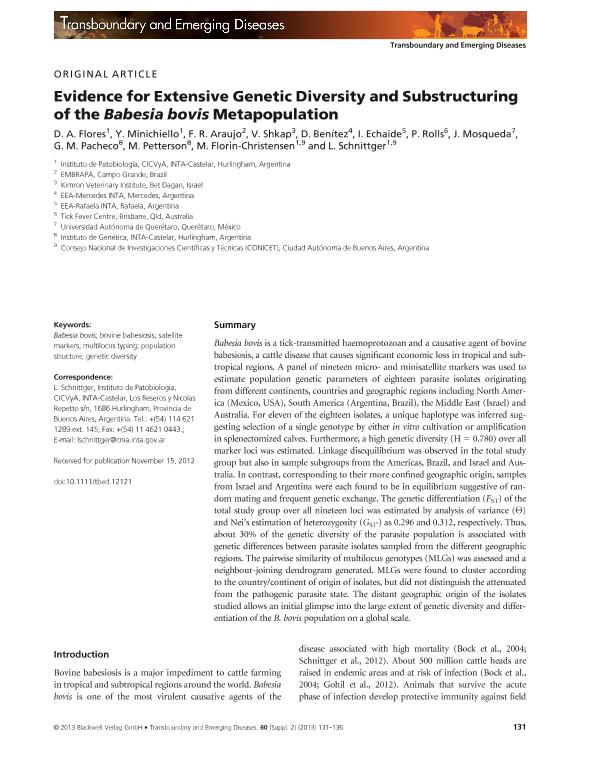Mostrar el registro sencillo del ítem
dc.contributor.author
Flores, Daniela Agustina

dc.contributor.author
Minichiello, Y.
dc.contributor.author
Araujo, F. R.
dc.contributor.author
Shkap, V.
dc.contributor.author
Benítez, D.
dc.contributor.author
Echaide, Ignacio Eduardo

dc.contributor.author
Rolls, P.
dc.contributor.author
Mosqueda, J.
dc.contributor.author
Pacheco, G. M.
dc.contributor.author
Petterson, M.
dc.contributor.author
Jacobsen, Monica Ofelia

dc.contributor.author
Schnittger, Leonhard

dc.date.available
2019-11-13T22:29:38Z
dc.date.issued
2013-11
dc.identifier.citation
Flores, Daniela Agustina; Minichiello, Y.; Araujo, F. R.; Shkap, V.; Benítez, D.; et al.; Evidence for Extensive Genetic Diversity and Substructuring of the Babesia bovis Metapopulation; Wiley Blackwell Publishing, Inc; Transboundary And Emerging Diseases; 60; SUPPL.2; 11-2013; 131-136
dc.identifier.issn
1865-1674
dc.identifier.uri
http://hdl.handle.net/11336/88833
dc.description.abstract
Babesia bovis is a tick-transmitted haemoprotozoan and a causative agent of bovine babesiosis, a cattle disease that causes significant economic loss in tropical and subtropical regions. A panel of nineteen micro- and minisatellite markers was used to estimate population genetic parameters of eighteen parasite isolates originating from different continents, countries and geographic regions including North America (Mexico, USA), South America (Argentina, Brazil), the Middle East (Israel) and Australia. For eleven of the eighteen isolates, a unique haplotype was inferred suggesting selection of a single genotype by either in vitro cultivation or amplification in splenectomized calves. Furthermore, a high genetic diversity (H = 0.780) over all marker loci was estimated. Linkage disequilibrium was observed in the total study group but also in sample subgroups from the Americas, Brazil, and Israel and Australia. In contrast, corresponding to their more confined geographic origin, samples from Israel and Argentina were each found to be in equilibrium suggestive of random mating and frequent genetic exchange. The genetic differentiation (FST) of the total study group over all nineteen loci was estimated by analysis of variance (Θ) and Nei's estimation of heterozygosity (GST') as 0.296 and 0.312, respectively. Thus, about 30% of the genetic diversity of the parasite population is associated with genetic differences between parasite isolates sampled from the different geographic regions. The pairwise similarity of multilocus genotypes (MLGs) was assessed and a neighbour-joining dendrogram generated. MLGs were found to cluster according to the country/continent of origin of isolates, but did not distinguish the attenuated from the pathogenic parasite state. The distant geographic origin of the isolates studied allows an initial glimpse into the large extent of genetic diversity and differentiation of the B. bovis population on a global scale.
dc.format
application/pdf
dc.language.iso
eng
dc.publisher
Wiley Blackwell Publishing, Inc

dc.rights
info:eu-repo/semantics/openAccess
dc.rights.uri
https://creativecommons.org/licenses/by-nc-sa/2.5/ar/
dc.subject
BABESIA BOVIS
dc.subject
BOVINE BABESIOSIS
dc.subject
GENETIC DIVERSITY
dc.subject
MULTILOCUS TYPING
dc.subject
POPULATION STRUCTURE
dc.subject
SATELLITE MARKERS
dc.subject.classification
Bioquímica y Biología Molecular

dc.subject.classification
Ciencias Biológicas

dc.subject.classification
CIENCIAS NATURALES Y EXACTAS

dc.title
Evidence for Extensive Genetic Diversity and Substructuring of the Babesia bovis Metapopulation
dc.type
info:eu-repo/semantics/article
dc.type
info:ar-repo/semantics/artículo
dc.type
info:eu-repo/semantics/publishedVersion
dc.date.updated
2019-10-23T14:45:51Z
dc.journal.volume
60
dc.journal.number
SUPPL.2
dc.journal.pagination
131-136
dc.journal.pais
Reino Unido

dc.journal.ciudad
Londres
dc.description.fil
Fil: Flores, Daniela Agustina. Consejo Nacional de Investigaciones Científicas y Técnicas; Argentina. Instituto Nacional de Tecnología Agropecuaria. Centro Regional Buenos Aires; Argentina
dc.description.fil
Fil: Minichiello, Y.. Instituto Nacional de Tecnología Agropecuaria. Centro Regional Buenos Aires; Argentina
dc.description.fil
Fil: Araujo, F. R.. Ministerio da Agricultura Pecuaria e Abastecimento de Brasil. Empresa Brasileira de Pesquisa Agropecuaria; Brasil
dc.description.fil
Fil: Shkap, V.. Kimron Veterinary Institute Israel; Israel
dc.description.fil
Fil: Benítez, D.. Instituto Nacional de Tecnología Agropecuaria. Centro Regional Corrientes. Estación Experimental Agropecuaria Mercedes; Argentina
dc.description.fil
Fil: Echaide, Ignacio Eduardo. Instituto Nacional de Tecnología Agropecuaria. Centro Regional Santa Fe. Estación Experimental Agropecuaria Rafaela; Argentina
dc.description.fil
Fil: Rolls, P.. Tick Fever Centre; Australia
dc.description.fil
Fil: Mosqueda, J.. Universidad Autónoma de Querétaro; México
dc.description.fil
Fil: Pacheco, G. M.. Instituto Nacional de Tecnología Agropecuaria. Centro Regional Buenos Aires; Argentina
dc.description.fil
Fil: Petterson, M.. Instituto Nacional de Tecnología Agropecuaria. Centro Regional Buenos Aires; Argentina
dc.description.fil
Fil: Jacobsen, Monica Ofelia. Consejo Nacional de Investigaciones Científicas y Técnicas; Argentina. Instituto Nacional de Tecnología Agropecuaria. Centro Regional Buenos Aires; Argentina
dc.description.fil
Fil: Schnittger, Leonhard. Consejo Nacional de Investigaciones Científicas y Técnicas; Argentina. Instituto Nacional de Tecnología Agropecuaria. Centro Regional Buenos Aires; Argentina
dc.journal.title
Transboundary And Emerging Diseases

dc.relation.alternativeid
info:eu-repo/semantics/altIdentifier/doi/http://dx.doi.org/10.1111/tbed.12121
dc.relation.alternativeid
info:eu-repo/semantics/altIdentifier/url/https://onlinelibrary.wiley.com/doi/full/10.1111/tbed.12121
Archivos asociados
